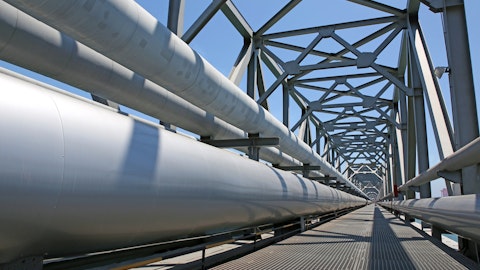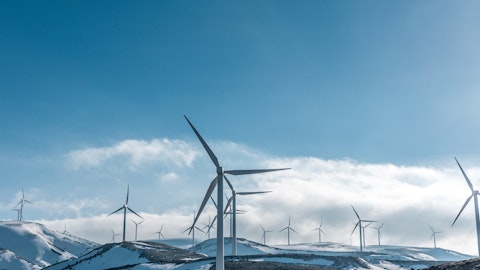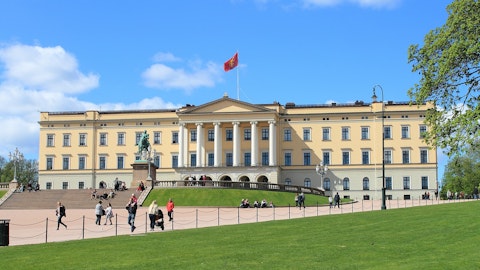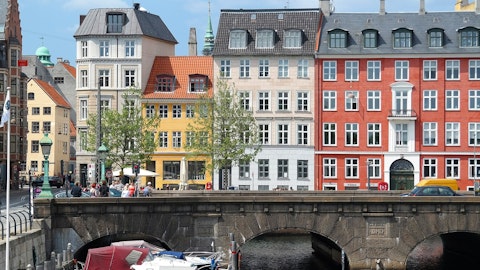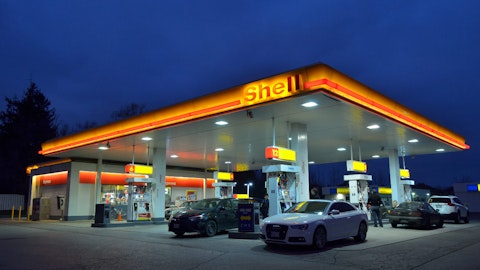Equinor ASA (NYSE:EQNR) Q4 2022 Earnings Call Transcript February 8, 2023
BÃ¥rd Glad Pedersen: Ladies and gentlemen, good afternoon. It is a pleasure to welcome you all to the presentation of Equinor’s Fourth Quarter and Full-Year Results for 2022 and our Capital Markets update. My name is BÃ¥rd Glad Pedersen, I am since December last year, heading up the Investor Relations team in Equinor. We have looked forward to engage with you all, and I will soon take you through the program for today. But safety first, if an emergency situation occurs while we are here, the evacuation signal is a voice announcement. We will only evacuate if the announcement say that we should do so. Then please follow the marked fire exits and the instructions from the guards, exiting is at the ground floor, and venue staff will show you to the assembly point.
Today we will have three presentations here in the plenary session. First of all, it’s Anders Opedal, our CEO; then our EVP for MMP, Irene Rummelhoff will present before the session is concluded with Torgrim Reitan, our CFO. After the presentations, there will be Q&A session where the three presenters will be on stage and also the CEC is here and available to respond. Following that, you are all invited to join us for our lunch. And for those of you who have signed up, there are breakout sessions with the EVPs for EPN, EPI, Ren, MMP, PDP and TDI afterwards. They will all give short introductions and ready to answer your questions. Finally, let me remind you that all the presentations here today are subject to the forward-looking statements that are included.
Then, Anders, we are ready to start and the floor is yours.
Anders Opedal: Thank you, BÃ¥rd and it’s really good to see you all and to me is a pleasure to welcome you finally here in London for our Capital Markets Update. And I and my team, we are really looking forward to share our financial results and the progress on strategy and ambitions. 2022 was our special year. The war in Europe still causes human suffering and has disrupted the energy markets contributing to inflation and cost of living crisis. In Europe, this year marks a shift as we move forward, not relying on Russian oil and gas. Equinor responded quickly and we are well positioned to be a part of the solution. Short-term, deliver the energy needed, longer-term to build up sustainable energy sources contributing to energy security and decarbonization.
Our milestone this year is the start-up of the Dogger Bank, the world largest offshore wind farm here in U.K. This leads me to the topic of the day, how we will deliver strong returns through the transition. Our strategy remains firm creating value on the way to Net Zero. We are progressing on optimizing oil and gas, high value growth in renewables and developing market opportunities in low carbon solutions. Position for high value creation, we expect a strong and resilient cash flow. In a $70 Brent scenario, we expect to deliver a very strong cash flow from operations. On average around $20 billion after tax annually all the way to 2030, we estimate an annual return of capital employed above 15% towards 2030. This strong outlook annually $20 billion after tax and solid financial position funds increased capital distribution and continued investments in profitable projects.
For fourth quarter 2022, we step-up our capital distribution and propose a 50% increase in the ordinary cash dividend through $0.30 per share. In combination with extraordinary dividend and share buyback, we expect a total distribution to shareholders of around $17 billion for 2023. I will revert to this, but let me first present our results. On safety, we have achieved improvements on key indicators over several years. Our serious incident frequency of 0.4 was stable from 2021, the best level ever so far. We had no serious well controlled incidents and hydrocarbon leakages are down. Total injury frequency was 2.5. We continue with our clear goal, all our people returning safely home from work every day. Last year, we enhanced security within cyber and for our assets, stricter security protocol, more training and closer collaboration with authorities, all of this to safeguard our people, operations and security of supply for our customers.
Sustainability is all about making progress for society. We are committed to creating local value and equal opportunities and protecting the environment. In 2022, we responded to the energy security situation by boosting our gas production and shipping more crude to Europe. I’m really proud of the hard work from colleagues to ensure safe and efficient supply of energy. This is a true team effort. And during the year, 2,600 new colleagues joined Equinor replacing and renewing competence, demonstrating our attractiveness in a tight labor market. Last year we delivered strong operational performance, five new fields on stream at a capacity of more than 200,000 barrels per day, around half of this from Johan Sverdrup Phase 2. In addition, we have put our floating wind farm, Hywind Tampen in production on NCS.
We delivered net operating income of $79 billion and adjusted earnings of $75 billion. This clearly demonstrate our ability to capture value from high prices and volatile markets. Our free cash flow before capital distribution came in at $32 billion. The earnings brought — this earnings brought return on capital employed to 55%. Across the portfolio, we have progressed on projects to reduce our own emissions. Our CO2 intensity ended at 6.9, well below half the industry average. We’re progressing our projects for decarbonization with CO2 transport and storage, including the Smeaheia license on NCS awarded last year, we have acreage to store around 30 million tons CO2 annually. Our strong cash flow outlook, continued capital discipline and robust balance sheet is the basis for the increase in capital distribution.
To me, it is important that the step-up provides highly competitive distribution for 2023 and increased predictability and commitment in the long run. The board proposes a 50% increase of the ordinary cash dividend from $0.20 to $0.30 per share from the fourth quarter. Our dividend policy remains firm. We expect to increase the annual ordinary cash dividend in line with long-term underlying earnings now from a higher base. In addition to the ordinary cash dividend, no above pre-COVID levels share buyback are an integrated part of our ordinary capital distribution. We continue the program we introduced back in 20 June, 2021 of $1.2 billion per year. The record earnings last year and our strong financial position also enables extraordinary distribution to shareholders in 2023.
We propose an extraordinary cash dividend of $0.60 per share for fourth quarter. This will bring total quarterly cash dividend to $0.90 per share subject to AGM approval. The board is clear in its intention to maintain this level for the first three quarters of 2023. In addition, we propose an extraordinary buyback of shares of $4.8 billion, making it $6 billion for the year. In total, this leads to a capital distribution to shareholders of around $17 billion in 2023. We are in a unique position to create value, providing energy, security and decarbonization. On liquids, gas and power production. Our liquids, gas and power production is high, but far exceeded by the volumes we sell and trade. Last year we sold more than 800 million barrels of liquids, a 100 BCMs of gas and traded more than 175 terawatt hours of power.
We optimize and create value from production, our infrastructure, and the volumes we sell and trade. On top of this, we will provide decarbonization through CCS and hydrogen. We leverage our fuel portfolio as we seek to develop new value chains with industrial partners and customers. Going forward, we are set to continue capturing high value from volatile and tight markets. On back of this, we increase our guiding for marketing midstream and processing by 60%. Creating and capturing value across our business, we estimate a free cash flow over the four years to 2026 of around $25 billion. We will continue to develop our profitable oil and gas portfolio. Last year we sanctioned 13 projects adding around 600 million barrels in reserves. We keep on exploring with around 35 exploration wells planned this year.
In 2023, we estimate a 3% production increase. By the end of the decade, we expect the production to be on par with today, while delivering a 50% reduction in our emissions. The estimated production will secure long-term supply of gas from NCS to Europe. We expect the average annual production to be above 40 BCMs throughout the decade. And our pipe gas to Europe have less than one-fifth of the CO2 intensity compared to LNG imports. Our Norwegian portfolio is the backbone of the company and we continue developing assets, increasing value creation. Internationally, we have further focused our portfolio with a clear mindset of value over volume. Kjetil and Philippe will show you how our Norwegian and international portfolio are set to deliver strong cash flow to 2030 and beyond.
Our oil and gas business is robust and cash flow neutral at around $30 per barrel, and we continue to improve. Our projects in execution have reduced costs since investment decision despite inflation. Here again, Irene will talk about execution excellence and how we manage cost and create value through technology implementation. Across the fuel company, including renewables and low carbon solutions, we plan to invest $10 billion to $11 billion in 2023 and around $13 billion annually from ’24 to ’26. No company including Equinor is shielded from the inflation and cost pressure in our industry. Capital discipline and cost management is high on our agenda and we take firm actions. We use flexibility and optionality in our portfolio. We collaborate closely with suppliers and we use new technology to reduce cost and increase production.
From this year and until 2026, we expect unit production costs for oil and gas below $6. We continue to work to manage cost and mitigate inflation and Torgrim will provide more details on this. Profitability is at the core as we grow in renewables, this is demanding and will require discipline. As history shows, we have one bids at price level supportive of value creation, also making us more robust towards impairments. Our California leads serves as a new demonstration. Our farmdowns have been at high price levels capturing the benefit of early access. We maintain our expectation of projects return of 4% to 8% real. As projects start production, power generation will grow rapidly and we have the optionality to prioritize the projects bringing the best returns.
We expect to grow our annual production from the 1.6 terawatt hours today to between 35 and 60 in 2030. PÃ¥l and Helge will show you how we will further increase value creation from this. We remain firm on strategy, but flexible on execution and continue putting value over volume. Equinor has safely stored CO2 for almost 30 years at the Sleipner field. We introduced low carbon solutions as the part of our corporate strategy in 2021. Since then, we have made strong progress. We are taking the lead in developing the North Sea as a hub for commercial carbon storage. And we are on track to store 15 million to 30 million tons CO2 per year by 2035. For our projects and plants in Europe and U.S., the recent policy developments will strengthen the commercial potential.
We see growing interest from — in CO2 storage and hydrogen from industrial customers. Irene will give more details, but let me share a few highlights. Last summer, Northern Lights on Norwegian Continental Shelf signed the first commercial agreement. In U.K. our East Coast cluster was shortlisted in the government clustering process. And in January, we announced a corporation with RWE in Germany for energy security and decarbonization. Together we aim to help Germany transition from coal to gas to low carbon hydrogen and finally hydrogen from renewables. We are collaborating on new value chains in several industrial clusters. By 2035, we aim to have three to five clean hydrogen projects. The energy transition will be demanding with difficult dilemmas.
We believe in a balanced transition and Equinor was solved for treating, reduce emission for ourself and our customers, build-up new energy sources and secure reliable energy. We will work hard to deliver on this, but at the same time, create value for shareholders and society. We continue to cut emissions from operations. Since 2015, we have cut almost 30% of our emissions on the way to net 50% reduction in 2030. The share of gross investments in renewable and low carbon is on track to our 30% share by 2025 and progressing towards with more than 50% in 2030. We are also progressing on our energy transition plan and remain committed to the ambition of Net Zero. So let me sum up. We are uniquely positioned to create value and strong cash flow on average around $20 billion after tax per year towards 2030.
We reaffirm our commitment and step-up capital distribution while investing in our profitable portfolio. We can deliver the energy needed while driving the transition to a low carbon future. So thank you everyone for the attention, and I look forward to the questions later. But first, Irene, happy birthday, and the floor is yours.
Irene Rummelhoff: Just hoping to keep that a secret. But there you go. Well, thank you, Anders, and it’s really good to see you all. I’ll cover three topics today. I’ll share some reflections on the gas market, then I’ll explain why we upped our guidance. And then thirdly, I’ll talk about and convince you that we’re uniquely positioned to develop low carbon value chains. So first, the gas market. You all know what happened to the Russian volumes last year and how Europe managed to replace them through increased exports from Norway, severe demand reduction, but also very costly LNG imports. Lately, we’ve seen some relief, a relief that is directly correlated to the fact that we’re in the midst of one of the warmest winters on record in Europe, and we actually saw demand reduction at 32% in January.
So now the gas market is all about preparing for next winter. And we do believe that it’s likely that storages will be built come November, the EU target or above 90%. But that requires continued demand reduction and high LNG imports levels. However, real relief will only come into this market beyond 2026, when we expect significant volumes coming in from Russia and Qatar. So in the meantime, the market will remain fundamentally tight and nervous, as my boss said earlier today. And I think there may be the three most or the biggest uncertainties to watch out for our weather, weather in Europe, weather in Asia, we saw how impactful that was this winter. Then it is also quite interesting to see whether for instance, industrial demand will come up again, now that we’ve kind of landed at a dampened level.
And the supply interruptions is always something to look out for, particularly in such a tight market. Going forward, we expect massive investments in renewables. If you couple that with the rapidly changing weather patterns, you will need energy storage. And the call up on flexible gas is expected to be significant. And I think a very illustrative example is what happened in Germany this winter. Between a cold day in December 13 and a warm and windy day on January 4. The difference in store — between storage injection versus withdrawals were 260 million cubic meter. And that’s actually equivalent to all the gas that we export from Norway on a normal day. Volatility is something that me and my team, we’ve talked about for quite some time. We expected it, and we have prepared for it.
Back in 2019, we changed our GAAP sales strategy, and we’re basically now selling all our gas on spot indexation meaning that we can capture volatility and price spikes like the one we saw in August this summer. And I also do hope that you have seen how we are working hard to mature these low carbon value chains and we do attack four elements in parallel and I think maybe that’s a little bit of a differentiator with respect to us. We work on the upstream production and storage. We work on the transportation and infrastructure, we work on the customer side and also the political support in parallel. If you don’t do that, you will not succeed. So, thank you for your attention and Torgrim, it’s your turn.
Torgrim Reitan: So thank you very much, Irene and thank you all for joining us today. It is very good to see you again and it is very good to be back as CFO in Equinor. Since my last time around, a lot has changed, but one thing remains constant, value creation is our top priority. After safety, this is the first priority and it is always more important than the volume targets. So coming into this role, I have two main priorities. First, that Equinor steer safely through volatility and through these uncertain times and commode as a stronger company. And second that we continue to be a leading company in the energy transition and deliver cash flow and creating value for shareholders. Our robust balance sheet and strong cash flow outlook position us well to transition in an investor-friendly way.
In 2022, we had solid operations and we contributed to energy security and at the same time we delivered a record returns and cashflow from operations. We stepped up or capital distribution and we invested more than ever in the energy transition. So this result does not come for free. My colleagues in Equinor have made significant improvements over the past years and we are all benefiting from that. So we’re in a good position and we have a strong balance sheet, but in times like this we need to prepare for lower prices and drive costs and capital discipline. So I will walk you through our financial framework after I’ve taken — talking to our results. So in the fourth quarter and full-year, we saw solid operations from oil and gas, against this dark backdrop of the Russian War on Ukraine, we completed or exit from Russia, the flexibility of our gas fields on the NCS enabled us to deliver more gas to Europe.
However, in the fourth quarter we reduced our gas position, gas production since gas demand fell. So we will produce this gas in later periods with higher demand. But this reduced production in the quarter by 48,000 barrels per day. Snøhvit produced for the full quarter, Johan Sverdrup Phase 2 and Norge Norway started up and Peregrino in Brazil ramped up. Power generation from renewables came in 6% higher for the full-year in addition to our renewable assets in operations. We are now generating power from gas from the Triton Power Station. For the full-year, we had a record net operating income of $79 billion, $79 billion and we delivered unprecedented adjusted earnings before and after tax. In the fourth quarter, we continued to deliver strong results and net income of $7.9 billion and adjusted earnings after tax of $5.8 billion.
So Equinor, we are not shielded from tight markets and inflation. We do see a growth in our OpEx and SG&A costs and the underlying increase is masked by the strengthening of the Dollar. So I will come back to how we are addressing costs. With the strong results from the U.S. business and the expectation that income will be taxable in a few years. We cannot recognize a deferred tax asset in the U.S. of $2.7 billion. We have net impairment reversals of around $1 billion in the quarter, mainly related to Mariner driven by an optimized production profile and higher prices. So let me turn to the segments. In the quarter on Norwegian Upstream business continued to deliver strong adjusted earnings before tax of $14.6 billion. Our international business excluding the U.S. had solid earnings driven by Peregrino ramp-up.
The U.S. business also delivered solid earnings. However production there was slightly lower due to a major planned turnaround on Caesar Tonga. Within MMP, we continue to see very strong results as you heard from Irene from gas and power sales and trading. We had negative derivative timing effects for the quarter and without those adjusted earnings for MMP would have been positive $1.8 billion, which is well above both the old and the updated guidance. The negative derivative effect is mostly within the 78% tax regime, which leads to a positive earnings of $1.9 billion after tax for MMP. And finally, we continue to build our renewable business and in this phase, we see a negative adjusted earnings. Our assets in operations have a positive contribution of $37 million up from $28 million last quarter.
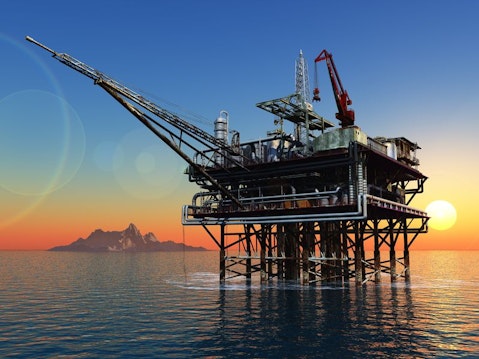
Copyright: 1971yes / 123RF Stock Photo
And then cash flow, for the full-year, we delivered record cash flow from operations of almost $84 billion and after subtracting taxes, including the additional tax payment last quarter of $10 billion and subtracting investments and capital distribution, we delivered a net cash flow for the year of around $23 billion. For the year, we had organic CapEx of around $8.1 billion, which was somewhat below our guidance, mainly due to phasing of project activity and currency effects. Based on the strong cash flow, our net debt ratio is further reduced to negative 23.9%. As you know, this is impacted by the lag in tax payments on the NCS. During the first half of 2023, we will pay three tax installments related to the NCS of NOK 54 billion each which is lower than indicated last quarter, and this is due to the recent reduction in gas prices.
So let’s move on to our financial framework. We have four important boundaries for how we will develop our company and how we want to drive capital discipline. First, we have value over volume, very, very important. Return on capital is key, and we expect to deliver on average, more than 15% for the period towards 2030. Secondly, as solid balance sheet is the basis for all good risk management, and we maintain our guidance of a long-term net debt ratio of 15% to 30%. And then thirdly, our industry is cyclical, and we must be prepared and we will remain robust in a $50 environment. And lastly, of course, we will transition with force in line with our energy transition plan. So within this framework, we expect a very strong cash flow over the next decade.
Cash flow from operations after tax of around $20 billion per year on average. So we will use this cash flow to create shareholder value. And we will allocate capital towards a competitive capital distribution. We will reinvest in our oil and gas activities in an attractive project portfolio with an average breakeven of $35 per barrel. And then we will continue to invest and grow in our high-quality project portfolio within REN and low-carbon solutions. So this financial framework is, as you understand, very important for us when we prioritize our spending going forward. Our capital distribution is a central part of our investor proposal, and this is important to us. The step-up is based on our outlook for strong returns and cash flow. The Board of Directors, they have proposed a 50% increase in the ordinary cash dividend to $0.30 per share per quarter, up from $0.20 last quarter.
So we expect to increase the annual cash dividend in line with the long-term underlying earnings, and now from a higher base of $0.30 per share. In addition, we remain committed to the share buyback program we introduced in 2021 with share buybacks of $1.2 billion annually as part of the long-term capital distribution. This project is subject with the same conditions we set when it was introduced. We will also continue with an extraordinary cash dividend with an additional share buyback in 2023. The extraordinary cash dividend will be $0.60 per share for the fourth quarter, making total cash dividend $0.90 per quarter. Our clear intention is to continue with this level for the following three quarters. The additional $4.8 billion in share buybacks brings the total program to $6 billion for 2023.
So in total, our capital distribution for 2023 is $17 billion, up from $13.7 million last year. The first tranche of this program of $1 billion will start tomorrow, and that will be based on the existing approval that we had from our Annual General Meeting. So as you understand, capital distribution is important to us. We are set to deliver a strong free cash flow of around $25 billion towards 2026 in a $70 reference case that is the free cash flow. This cash flow has both longevity and is resilient towards lower prices. As you can see, our company will be cash neutral, cash flow neutral at around $50 per barrel, meaning that cash flow from operations will cover planned investments at those prices. From ’24, more than half of our CapEx will be linked to our non-sanctioned projects giving us significant flexibility going forward.
We expect to increase our investments in both oil and gas and in renewables and low carbon solutions. I started out with one of my key priorities to ensure that Equinor steered safely through uncertain times and volatility. So this will require strong cost and capital discipline and we are prepared. The picture of Johan Castberg is no coincidence. In 2014, in times of high cost pressure we postponed Castberg rework the concept and reduced CapEx by 50% — by more than 50%. We do the same today and that is why we decided to postpone the large Barents Sea development Wisting. So we will continue to improve a mature Wisting to make it even better and more robust. To build resilience, we need portfolio flexibility, and we need to execute project efficiently.
And as a large operator with a strong investment program, we have exactly that. We set out on a $4 billion improvement ambition from 2020 to 2025. I’m glad to announce that we have already delivered three years ahead of schedule. So this was driven mainly by production optimization and utilizing our integrated operations center. In 2022, we saw an increase in unit production cost to around $6 per barrel driven by higher energy costs and CO2 prices in addition to Peregrino and Snøhvit coming back online. So we expect to be able to maintain at that level or lower towards 2026. We are working strategically with suppliers to drive efficiency across projects and using standardization to ensure pace and scale. So this has delivered more than 5% lower project facility costs and more than 45% lower drilling costs compared to peers.
So we will continue to drive improvements Hege and Geir will speak more to this in the breakout session. And now to our oil and gas project portfolio. Our projects coming on stream over the next 10 years will create large value, low break evens of around $35 per barrel, high returns of around 30% internal rate of return, short payback time of around two and a half years and a low-carbon upstream intensity of less than 6-kilo per of CO2 per barrel, which is less than half of the global industry average. So through this portfolio, we will deliver strong production and cash flow to 2030 and beyond. We will reduce Scope 1 and 2 emissions by 50%, while we are doing exactly that. So we sanctioned many projects in 2022, and this portfolio is to a large extent protected against inflation with contracts already awarded.
Our non-sanctioned portfolio is more exposed to cost pressures and changes in supplier markets. So we will continue to work hard to mitigate these pressures. And rest assured, we will not sanction projects that are not good enough just to drive growth. We are investing to create as much value as possible. We have an extensive portfolio of renewables and low carbon projects. We see significant synergies for them to be part of Equinor. First, with access to our strong balance sheet, we can reduce funding costs. We can warehouse risk and we can take on merchant risk. Also, working closely with our marketing and trading business will lift returns. And finally, we have, of course, deep competence and execution skills that these projects will capitalize on.
So we will maintain a disciplined approach, and we will focus on value over volume, and PÃ¥l and Helge will go into this later. And by the way, I hope you saw Monday’s news on Dogger Bank D, where we together with SSE are looking into a fourth phase of the world’s largest offshore wind farm. So let me conclude. We expect to invest $10 billion to $11 billion in 2023 making CapEx for ’22 and ’23 slightly lower than what we said last year. For ’24 to ’26, we expect annual CapEx of around $13 billion. Important to note that CapEx will be back end loaded in that period. The CapEx program is driven by stable investments within oil and gas. Growing CapEx in renewables and low carbon solutions and that we intend to use our balance sheet more within renewables as sort of there is an increasing value in that.
So that is the driver behind the CapEx program. In 2023, we expect to deliver 3% production growth in oil and gas. Towards ’26, we will continue to grow production, and in 2030, we expect production to be on par with where we are today. So finally, I hope we have shown you how well positioned we are to transition and create value in an investor friendly way. First, we will deliver strong cash flow and returns over the next decade. Secondly, we are committed to our competitive capital distribution. And thirdly, we will lead the way in the energy transition. And all of this will be done within the — a firm financial framework that we discussed just a few minutes back. So thank you very much for your attention. And then Board, I would like to hand it back to you to help us through the Q&A.
So thank you.
A – BÃ¥rd Glad Pedersen: Thank you, Anders, Irene, and Torgrim. We are then ready to start the Q&A session. The Q&A is reserved for analyst investors here in the room, but also those participating on the phone. And to make sure that we have time to cover as many as possible. I ask that you limit yourself to one question each and that you try to keep that crisp. I also ask that you introduce yourself at the start of the questions. So then we can start here at the front, and then we’ll make a list.
See also 20 Least Populated States in America and 10 Hot Tech Stocks To Buy Now.
Q&A Session
Follow Equinor Asa (NYSE:EQNR)
Follow Equinor Asa (NYSE:EQNR)
Martijn Rats: Hello. It’s Martijn Rats, I’m with Morgan Stanley. I wanted to ask you about the European gas markets, if I can only limit it to one topic. So last year, so part of the incremental gas supply from Norway to Europe was at the expense of some oil production, because it was gas that was otherwise reinjected. And I was wondering, given the balance of prices at the moment, whether you could reverse that, i.e., less gas, but then at the benefit of oil production? And secondly, on the same topic, I wanted to ask you, when you mentioned we lowered gas supply to Europe in the fourth quarter, because of the lower demand. That sort of sounds a bit like OPEC. It sounds a bit like some sort of market management going home. Now of course, the obvious question would be to ask at what price level would you expect to start doing that going forward?
I’m sure you won’t answer that question, but I was hoping you could say a few things about the circumstances under which you might sort of be quite dynamic and active, is it demand? Is it inventories? Is it price? I think that would be very helpful.
Anders Opedal: Yes. Thank you. And you prepare for the last question. And we — as you said, we are injecting — selling the gas to the market instead of injecting into some the reservoir. This is something that we monitor very, very closely in terms of long-term value creation and making sure that we are developing the reserves and not leaving reserves behind. So this is a kind of trade-off between what is the equivalent liquid price for gas compared to the oil. And if you see that gas prices are lower than the oil prices, and we are seeing that we will might lose out a long-term value, we might change this, because again, this is about creating long-term value.
Irene Rummelhoff: What I think it’s important to note that gas is still $120 oil equivalent. So it’s still a high level of prices. I think with respect to your question on moving gas further out in time. I alluded in my presentation to the fact that we have an increasingly flexible portfolio. And what do I mean by that? We have flexibility upstream, some of our gas fields are now coming very close to the client phase, which means that depending on the price signals, where the demand is needed, we can choose to produce the gas now or we can move it to one year ahead of in time or two years ahead of time. So it’s basically an optimization on prices, but it’s reflective of the demand situation in Europe. So using the upstream production more or less as a gas stored.
BÃ¥rd Glad Pedersen: Good. Let me move to you and here in the front next.
Lydia Rainforth: It’s Lydia Rainforth from Barclays. And I want to come back, obviously, $75 billion is an amazing profit number, and you’re matching it with $17 billion of cash returns to shareholders. Why is that the right number for ’23? Because obviously, you could have phased it more on cap payouts higher for longer, but just at a lower level. So I’m just wondering why $17 billion is the right number for this year? And this isn’t quite linked to that, but Torgrim, just on the tax side, obviously, the tax PAT guidance for first half is much lower than it was for the second half, I think, in terms of what you actually paid. So I’m just wondering, is that purely a price thing for it?
Anders Opedal: When we look at the capital distribution. Now the shareholder distribution, as we said today, we’re increasing the ordinary cash dividend to give the long-term commitment based on the long-term underlying earnings. And together with the $1.2 billion in share buyback, this demonstrates how we see — feel about the business going forward. Then, as you know, we have a very, very strong balance sheet, and we are a negative net debt ratio. And we have said and as Torgrim said also it today that we are moving towards our long-term guiding of 15 to 30, the balancing between the ordinary dividend and the extraordinary dividend is what we feel is the right for optimal capital structure in the long run. And Torgrim, you got a question?
Torgrim Reitan: Yes. Thanks, Lydia. You’re right. So since we sort of initially gave expectations for taxes, gas prices have fallen significantly. So that’s the reason why we are reducing sort of the cash tax payment expectations for the first half.
BÃ¥rd Glad Pedersen: Let’s move to the front here, and then , and then we’ll take one from the phone after that.
Oswald Clint: Thank you very much. It’s Oswald Clint at Bernstein. It was good to see the enthusiasm from Irene on the customer side. I always look for more of that from Equinor versus your customer-rich competitors. But — so RWE, NG , the deals you’ve laid out, you didn’t quite talk about expected returns from these chains. Torgrim showed us 30% in the upstream, you said it took a lot of time to strike these deals, but you’re selling gas, then blue hydrogen, then green hydrogen and there’s different pricing going on there, which is quite opaque to us. So maybe just talk about what are these integrated returns that you can tell us that we should expect? And just a linked side question. In those discussions, do you think Russian gas could ever make a way back into Germany? Thank you.
Anders Opedal: Yes, I’ll start a little bit, and you can comment on the Russian gas as well. We have progressed very well on both working together with NG and RWE and gradually building up this new value chain that is so important to decarbonize the industry in Germany and Europe. We see that this will be based on contracts for differences in — particularly for hydrogen and also the ETS price will drive the prices more for the carbon services. So we are seeing returns and it’s too early to guide on this, because we are uniquely positioned, and we’re going to really be one of the first one developing this, but we will see returns in the same range as we say for renewables. But too early to say exactly. But we worked really hard to develop these projects and make them as good as possible using the same toolbox as we have used for renewables and oil and gas projects to make these projects profitable.
Irene Rummelhoff: And I think there are two phases with respect to these kind of projects. It’s one where we will need subsidies, both for the CO2 value chains and the hydrogen value chains. But I think when you get closer to 2030, the EU ETS prices going to be higher than the cost of capturing and storing CO2. So then you get into a commercially driven environment, and you could expect to see different returns at that point in time. But — the other thing I would want to highlight compared to the renewables is that the entry barrier into this space is much higher. So if you start out on a level you’re more likely to be able to hold on to that level than what we have seen in some of the renewable businesses. Then you asked whether I think Russian gas will come back to Germany.
And I would say no, today. But then we also know that politics changes times move on. So — but within the — we have no assumptions in our models of seeing Russian gas coming back to Europe in the next three to four years. I think what will happen, though, is some of the Russian gas will be rerouted to China via pipeline, they might expand their LNG export capacity or so. So I don’t think it necessarily will disappear from the market, but it seems as of now, at least very unlikely that it will hit the German market anytime soon.
BÃ¥rd Glad Pedersen: Let’s do and then we do one from the phone afterwards.

